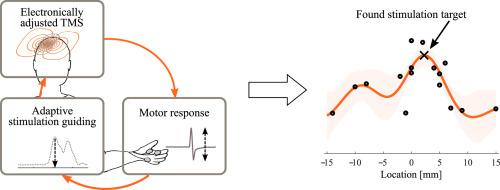当前位置:
X-MOL 学术
›
NeuroImage
›
论文详情
Our official English website, www.x-mol.net, welcomes your
feedback! (Note: you will need to create a separate account there.)
Automated search of stimulation targets with closed-loop transcranial magnetic stimulation
NeuroImage ( IF 4.7 ) Pub Date : 2020-10-01 , DOI: 10.1016/j.neuroimage.2020.117082 Aino E Tervo 1 , Johanna Metsomaa 2 , Jaakko O Nieminen 1 , Jukka Sarvas 1 , Risto J Ilmoniemi 1
NeuroImage ( IF 4.7 ) Pub Date : 2020-10-01 , DOI: 10.1016/j.neuroimage.2020.117082 Aino E Tervo 1 , Johanna Metsomaa 2 , Jaakko O Nieminen 1 , Jukka Sarvas 1 , Risto J Ilmoniemi 1
Affiliation

|
Transcranial magnetic stimulation (TMS) protocols often include a manual search of an optimal location and orientation of the coil or peak stimulating electric field to elicit motor responses in a target muscle. This target search is laborious, and the result is user-dependent. Here, we present a closed-loop search method that utilizes automatic electronic adjustment of the stimulation based on the previous responses. The electronic adjustment is achieved by multi-locus TMS, and the adaptive guiding of the stimulation is based on the principles of Bayesian optimization to minimize the number of stimuli (and time) needed in the search. We compared our target-search method with other methods, such as systematic sampling in a predefined cortical grid. Validation experiments on five healthy volunteers and further offline simulations showed that our adaptively guided search method needs only a relatively small number of stimuli to provide outcomes with good accuracy and precision. The automated method enables fast and user-independent optimization of stimulation parameters in research and clinical applications of TMS.
中文翻译:

使用闭环经颅磁刺激自动搜索刺激目标
经颅磁刺激 (TMS) 协议通常包括手动搜索线圈或峰值刺激电场的最佳位置和方向,以引发目标肌肉的运动反应。这种目标搜索很费力,而且结果取决于用户。在这里,我们提出了一种闭环搜索方法,该方法利用基于先前响应的刺激的自动电子调整。电子调整是通过多位点 TMS 实现的,刺激的自适应引导基于贝叶斯优化的原理,以最大限度地减少搜索所需的刺激数量(和时间)。我们将我们的目标搜索方法与其他方法进行了比较,例如在预定义的皮质网格中进行系统采样。对五名健康志愿者的验证实验和进一步的离线模拟表明,我们的自适应引导搜索方法只需要相对较少的刺激即可提供具有良好准确性和精确度的结果。该自动化方法可以在 TMS 的研究和临床应用中快速且独立于用户优化刺激参数。
更新日期:2020-10-01
中文翻译:

使用闭环经颅磁刺激自动搜索刺激目标
经颅磁刺激 (TMS) 协议通常包括手动搜索线圈或峰值刺激电场的最佳位置和方向,以引发目标肌肉的运动反应。这种目标搜索很费力,而且结果取决于用户。在这里,我们提出了一种闭环搜索方法,该方法利用基于先前响应的刺激的自动电子调整。电子调整是通过多位点 TMS 实现的,刺激的自适应引导基于贝叶斯优化的原理,以最大限度地减少搜索所需的刺激数量(和时间)。我们将我们的目标搜索方法与其他方法进行了比较,例如在预定义的皮质网格中进行系统采样。对五名健康志愿者的验证实验和进一步的离线模拟表明,我们的自适应引导搜索方法只需要相对较少的刺激即可提供具有良好准确性和精确度的结果。该自动化方法可以在 TMS 的研究和临床应用中快速且独立于用户优化刺激参数。









































 京公网安备 11010802027423号
京公网安备 11010802027423号